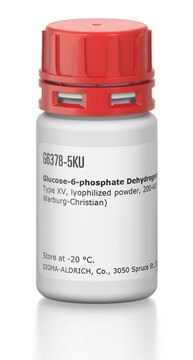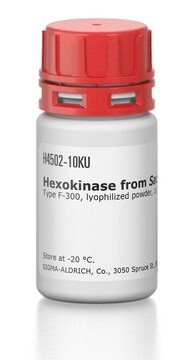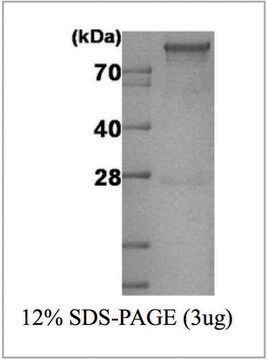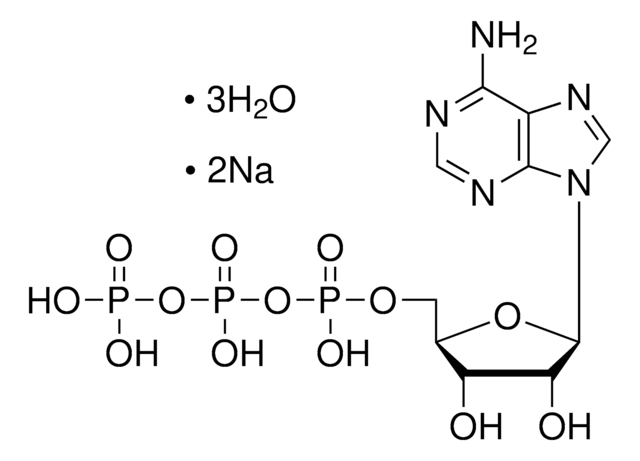Wszystkie zdjęcia(1)
Kluczowe dokumenty
HKG6PDH-RO
Roche
Hexokinase/Glucose-6-Phosphate Dehydrogenase (HK/G6P-DH)
from yeast/Leuconostoc, overproducer
Synonim(y):
G6P-DH, Glucose-6-Phosphate DehydrogenaseHK, Hexokinase
Zaloguj sięWyświetlanie cen organizacyjnych i kontraktowych
About This Item
Kod UNSPSC:
12352204
Polecane produkty
pochodzenie biologiczne
yeast
Poziom jakości
Formularz
suspension
masa cząsteczkowa
dimer 110,000 Da
opakowanie
pkg of 10 mL (10737275001 [30 mg])
pkg of 5 mL (10127825001 [15 mg])
producent / nazwa handlowa
Roche
stężenie
3.21 mg/mL
metody
activity assay: suitable
kolor
white
pH
5.5-6.5
rozpuszczalność
water: miscible
przydatność
suitable for UV spectrophotometry and general use
Zastosowanie
life science and biopharma
temp. przechowywania
2-8°C
Opis ogólny
Hexokinase is responsible for catalyzing the first step of glycolysis. It results in the formation of glucose-6-phosphate and ADP from glucose and ATP. Glucose-6-phosphate dehydrogenase is a crucial enzyme in the pentose phosphate pathway. It is responsible for the conversion of glucose-6-phosphate and NADP+ (nicotinamide adenine dinucleotide phosphate) to 6-phosphogluconolactone and NADPH.
Zastosowanie
Hexokinase/Glucose-6-phosphate dehydrogenase has been used for the determination of plasma glucose levels.
Komponenty
EC 2.7.1.1 & 1.1.1.49
Definicja jednostki
One unit (U) HK will phosphorylate 1 μmol of D-glucose in one minute at +25 °C and pH 7.6.
One unit (U) G6P-DH will oxidize 1 μmol of glucose-6-phosphate in one minute at +25 °C and pH 7.6.
The coupled assay produces 1 μmol of NADH per μmol of D-glucose phosphorylated.
Volume Activity: 340 U hexokinase/ml at +25 °C with glucose and ATP as the substrates. 170 U glucose-6-phosphate dehydrogenase/ml at +25 °C with glucose-6-phosphate as the substrate
One unit (U) G6P-DH will oxidize 1 μmol of glucose-6-phosphate in one minute at +25 °C and pH 7.6.
The coupled assay produces 1 μmol of NADH per μmol of D-glucose phosphorylated.
Volume Activity: 340 U hexokinase/ml at +25 °C with glucose and ATP as the substrates. 170 U glucose-6-phosphate dehydrogenase/ml at +25 °C with glucose-6-phosphate as the substrate
Postać fizyczna
Suspension in 3.2 M ammonium sulfate solution, pH approximately 6. Prepared by mixing hexokinase with G6P-DH. HK:G6P-DH approximately 2:1 with regard to protein content.
Inne uwagi
For life science research only. Not for use in diagnostic prodcedures.
Ta strona może zawierać tekst przetłumaczony maszynowo.
Kod klasy składowania
12 - Non Combustible Liquids
Klasa zagrożenia wodnego (WGK)
WGK 1
Temperatura zapłonu (°F)
does not flash
Temperatura zapłonu (°C)
does not flash
Wybierz jedną z najnowszych wersji:
Masz już ten produkt?
Dokumenty związane z niedawno zakupionymi produktami zostały zamieszczone w Bibliotece dokumentów.
Klienci oglądali również te produkty
H Pelicano et al.
Oncogene, 25(34), 4633-4646 (2006-08-08)
Most cancer cells exhibit increased glycolysis and use this metabolic pathway for generation of ATP as a main source of their energy supply. This phenomenon is known as the Warburg effect and is considered as one of the most fundamental
Miguel Vázquez-Velasco et al.
Nutricion hospitalaria, 32(6), 2718-2724 (2015-12-17)
Type 2 diabetes is a very prevalent chronic disease. Among dietary factors for its prevention and treatment, interest has grown in satiating fibre (konjac glucomannan) and spirulina. Our previous studies suggest that glucomannan itself and/or in conjunction to spirulina displayed
K Gottlob et al.
Genes & development, 15(11), 1406-1418 (2001-06-08)
The serine/threonine kinase Akt/PKB is a major downstream effector of growth factor-mediated cell survival. Activated Akt, like Bcl-2 and Bcl-xL, prevents closure of a PT pore component, the voltage-dependent anion channel (VDAC); intracellular acidification; mitochondrial hyperpolarization; and the decline in
Robert C Stanton
IUBMB life, 64(5), 362-369 (2012-03-21)
Glucose-6-phosphate dehydrogenase (G6PD) is the rate-limiting enzyme of the pentose phosphate pathway. Many scientists think that the roles and regulation of G6PD in physiology and pathophysiology have been well established as the enzyme was first identified 80 years ago. And
Nasz zespół naukowców ma doświadczenie we wszystkich obszarach badań, w tym w naukach przyrodniczych, materiałoznawstwie, syntezie chemicznej, chromatografii, analityce i wielu innych dziedzinach.
Skontaktuj się z zespołem ds. pomocy technicznej









